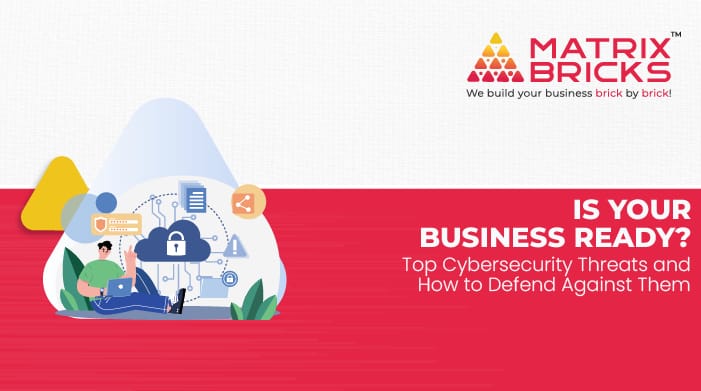
In today’s digital age, the importance of robust cyber security cannot be overstated. As businesses become increasingly reliant on technology, they are also becoming more vulnerable to various cybersecurity threats. The impact of a cyber attack can be devastating, ranging from financial losses to reputational damage. Therefore, understanding the types of cybersecurity solutions is essential for every organisation.
In this blog, we’ll explore the top cybersecurity threats faced by businesses today and provide strategies to defend against them.

1. Phishing Attacks
Phishing is one of the most common types of cyber security threats that businesses face. It involves cybercriminals sending deceptive emails or messages, posing as legitimate entities, to trick employees into revealing sensitive information like passwords, credit card numbers, or personal details. When malicious links or attachments in these emails are clicked, it can result in data breaches.
How to Defend Against Phishing Attacks:
Educate Employees:
Conduct regular training sessions to educate employees on recognising phishing attempts.
Implement Multi-Factor Authentication (MFA):
This adds an extra layer of security by requiring more than just a password to access sensitive information.
Use Advanced Email Filtering:
Employ email filtering tools that can detect and block phishing emails before they reach employees.
2. Ransomware Attacks
Ransomware is a type of malware that encrypts a victim’s data and demands payment in exchange for unlocking it. It’s a growing concern for businesses of all sizes, as ransomware attacks can disrupt operations, cause data loss, and lead to significant financial damage.
How to Defend Against Ransomware Attacks:
Regular Backups:
To guarantee that data may be recovered without having to pay a ransom, keep regular backups of important data in safe, offline locations.
Endpoint Protection:
Deploy robust endpoint security solutions that detect and block ransomware before it executes.
Patch Management:
Ensure all software and systems are updated with the latest security patches to prevent vulnerabilities from being exploited.
3. Insider Threats
Insider threats involve malicious or negligent actions by employees or contractors who have access to sensitive company information. These threats can be particularly challenging to detect because they originate from within the organisation.
How to Defend Against Insider Threats:
Strict access restrictions should be put in place to guarantee that workers only have access to the information required for their jobs.
Employee Monitoring:
Use monitoring tools to detect unusual or suspicious behaviour that could indicate a potential insider threat.
Regular Audits:
Conduct regular security audits to identify vulnerabilities and ensure compliance with security policies.
4. Distributed Denial of Service (DDoS) Attacks
A denial-of-service (DDoS) attack happens when hackers overload a network or website with traffic, making it unavailable to authorised users. These attacks can lead to significant downtime, loss of revenue, and damage to a business’s reputation.
How to Defend Against DDoS Attacks:
DDoS Protection Services:
Use specialised DDoS protection services that can detect and mitigate attacks before they impact your business.
Network Redundancy:
Build redundancy into your network architecture to ensure that even if one server is attacked, others can take over.
Rate Limiting:
Implement rate limiting on your servers to control the number of requests that can be made to your website at any given time.
5. Malware Attacks
Malware, or malicious software, encompasses various types of cyber security threats, including viruses, worms, trojans, and spyware. These malicious programs are designed to damage, disrupt, or gain unauthorised access to computer systems.
How to Defend Against Malware Attacks:
Antivirus and Anti-Malware Software:
Ensure that all devices have up-to-date antivirus and anti-malware software installed.
Regular Software Updates:
Keep all software, especially operating systems, updated to patch known vulnerabilities.
User Awareness Training:
Educate employees about the dangers of downloading files or clicking on links from unknown sources.
6. Advanced Persistent Threats (APTs)
APTs are complex cyberattacks in which a hacker enters a network without authorisation and stays hidden for a long time. These attacks are often aimed at stealing sensitive data or causing long-term damage.
How to Defend Against APTs:
Network Segmentation:
Divide the network into segments to contain any potential breaches.
Continuous Monitoring:
Implement continuous network monitoring tools to detect unusual activity or unauthorised access.
Incident Response Plan:
Develop and regularly update an incident response plan to quickly address and mitigate any detected threats.
7. Man-in-the-Middle (MitM) Attacks
A MitM attack involves the interception and possible modification of communication between two parties by the attacker without their knowledge. This can lead to data breaches, financial losses, and compromised communication.
Encryption:
Ensure that all data transmitted over the network is encrypted using secure protocols like SSL/TLS.
Secure Wi-Fi:
Avoid using public Wi-Fi networks for sensitive transactions and ensure your company network is secure.
Virtual Private Networks (VPNs):
Use VPNs to secure communication channels, especially when employees are working remotely.
8. Social Engineering Attacks
Social engineering is the process of getting someone to provide personal information. It is especially difficult to defend against these attacks since they frequently rely on human error.
How to Defend Against Social Engineering Attacks:
Awareness Training:
Conduct regular security awareness training to educate employees about social engineering tactics.
Verification Protocols:
Implement strict verification protocols for sensitive information requests.
Incident Reporting:
Encourage employees to report any suspicious requests or interactions.
Key Strategies for Defending Against Cybersecurity Threats
Given the wide range of cybersecurity threats, businesses must adopt a comprehensive approach to protect their assets. Here are some key strategies:
Risk Assessment:
Regularly assess the potential risks to your organisation and implement measures to mitigate them.
Security Policies:
Develop clear cybersecurity policies and ensure they are communicated to all employees.
Regular Updates and Patching:
Keep all systems and software up to date to minimise vulnerabilities.
Incident Response Plans:
Prepare a well-documented incident response plan to deal with potential cyber security incidents promptly.
Cyber Insurance:
To protect yourself against any financial losses brought on by a cyberattack, think about getting cyber insurance.
Conclusion
The landscape of cybersecurity threats is constantly evolving, and businesses must be proactive in defending against them. By understanding the various types of cyber security threats and solutions, organisations can significantly reduce their risk of falling victim to an attack. From phishing and ransomware to insider threats and social engineering, staying informed and prepared is the key to safeguarding your business.
Adopting a multi-layered security approach, including employee training, robust security software, and continuous monitoring, will help protect against the ever-growing range of cybersecurity threats and solutions. In an era where data breaches and cyber-attacks are becoming more frequent, prioritising cyber security is not just a necessity—it’s a critical component of long-term business success.






